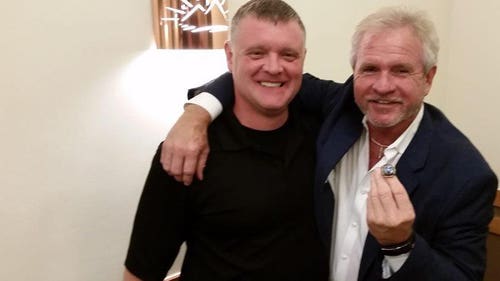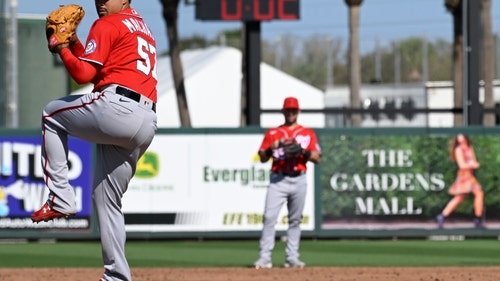
Pittsburgh Pirates RHP Tyler Glasnow Scouting Report
Sep 25, 2016; Pittsburgh, PA, USA; Pittsburgh Pirates starting pitcher Tyler Glasnow (51) delivers a pitch against the Washington Nationals during the first inning at PNC Park. Mandatory Credit: Charles LeClaire-USA TODAY Sports
Pittsburgh Pirates righty Tyler Glasnow has likely moved into the role of the top-rated pitching prospect in the game with Alex Reyes out for the year.
Player Profile
The Pittsburgh Pirates drafted Tyler Allen Glasnow out of high school in California in the 5th round of the 2011 draft.
That year's draft has turned to be one of particular value for the team, producing Gerrit Cole already, with Josh Bell likely to start in 2017. There are other players still working their way through the system, but one that did not sign of note was 20th round selection Trea Turner, who went to college and is now a big part of the Washington Nationals future.
Glasnow opened with the Pirates' Gulf Coast League team, and he finished with one appearance with the New York-Penn League team in State College.
Overall, his 2012 line was 12 appearances, 38 1/3 innings pitched, a 1.88 ERA, 1.04 WHIP, a 10.83% walk rate, and a 28.03% strikeout rate.
Glasnow made enough of an impression with the Pirates to go straight to West Virginia of the low-A South Atlantic League for all of 2013 as a 19 year-old. He made 24 starts, throwing 111 1/3 innings, posting a 2.18 ERA, 1.03 WHIP, 13.5% walk rate, and a 36.28% strikeout rate.
His impressive performance as a teenager in full season ball shot him up ranking lists. Baseball America ranked him at #46 overall, MLB Pipeline had him at #27, and Baseball Prospectus had him at #42.
Glasnow certainly did not slow down with his promotion to high-A Bradenton in the Florida State League in 2014. He made 23 starts, throwing 124 1/3 innings with a 1.74 ERA, 1.05 WHIP, 11.56% walk rate, and 31.85% strikeout rate.
The Pirates sent Glasnow to the Arizona Fall League among the best prospects in the game, and he held his own, making 7 appearances, throwing 19 1/3 innings with a 3.72 ERA and 1.66 WHIP, posting a 13.95% walk rate and a 23.26% strikeout rate as one of the youngest players in the AFL.
His continued excellent performance allowed him to continue a rise up the rankings. BA had him #16, MLB #12, and #21 by BP.
Glasnow opened 2015 with AA Altoona, earning a midseason promotion to AAA Indianapolis. As a 21 year-old pitching in the high minors, he still found the sledding quite favorable, making 22 starts, throwing 109 1/3 innings, with a 2.39 ERA, 1.10 WHIP, 9.66% walk rate, and 30.56% strikeout rate.
Often noting his improved walk rate in the upper minors while maintaining his elite strikeout rate, Glasnow pushed his way even further up ranking lists, to #14 in BA's list, #10 with MLB, and #11 with BP.
2016 brought an opening assignment to AAA Indianapolis, and Glasnow ended up spending much of July bouncing between Pittsburgh and Indianapolis before an injury sent him on a rehab that just happened to coincide with Altoona's playoff push at the AA level.
He returned to the big leagues in September, initially working out of the bullpen in his first few appearances before getting a couple starts to close out the year.
On the 2016 minor league season, Glasnow made 22 starts, throwing 116 2/3 innings with a 1.93 ERA, 1.17 WHIP, 14.62% walk rate, and a 30.97% strikeout rate.
With the Pirates, he made 7 appearances, 4 of them starts, posting a 4.24 ERA, 1.50 WHIP, 12.38% walk rate, and a 22.86% strikeout rate.
Scouting Report
More from Call to the Pen
Size/Delivery/Control
Size – Glasnow is listed at 6'8″ and 220 pounds. To the naked eye, those numbers certainly look correct as Glasnow is built long and lanky with long legs and arms. He certainly could be another 15-20 pounds heavier on his frame without really losing that "lanky" look.
Delivery – Glasnow begins his deliver seemingly from the stretch position, with his feet slightly open to the plate, but similarly structured to the stretch position.
From that spot, he takes a small step straight back, adjusts his right foot in front of the rubber, and lifts his left knee to just under his numbers, where he taps his knee with his glove before exploding to the plate.
Like many guys with long legs and long arms, Glasnow has his primary issues with his landing spot within his delivery, taking a long stride with his long legs toward the plate and frequently finding his landing spot inconsistent throughout the course of a game.
I did notice in his first two appearances of the spring a change in his delivery that the reports from Pirates spring training have been were intended to help with consistency in his delivery.
From the point of his first step backward, which is fairly slow and measured, previously Glasnow would move extremely fast through the rest of his delivery, and with long limbs, that can be disastrous, even with the simplified delivery that he had.
This spring however, I did note that he moved more slowly and deliberately through his delivery, allowing him to be more consistent in his landing spot and repeat things much better.
Glasnow also comes from an over-the-top arm slot, throwing from a high 3/4 arm position, giving his pitch even more plane.
Control (45) – With mixed results in his first two outings in the spring, Glasnow's changed delivery has not solved his control issues.
At his height, Glasnow is always going to be a concern with his mechanics, as are most guys with his long levers. Even if he were to end up in the bullpen, where he could be an incredibly elite reliever, Glasnow's delivery will always leads to concerns with his control.
Pitches
Fastball (70) – Glasnow's fastball is an incredibly difficult pitch for hitters to work with, which is what leads to his low contact rates.
From his height, his pitch has the effect of a sinker or two-seamer, but the pitch is a traditional four-seam fastball. He can touch upper 90s with his fastball, even reportedly topping triple digits in short bursts, but he typically sits in the 92-95 range with the pitch.
Change Up (45) – Glasnow's change can flash so good, yet it can also have such poor performance as well. He has a habit of overthrowing the pitch, letting it sit around 90 MPH, which puts minimal variance between the change and fastball.
The other major issue is his location of the change. Glasnow gets more movement on his change than his fastball, getting a more natural fastball movement than his actual fastball and actually having "rise" like a fastball.
Rather than some natural sink that a change typically gets, Glasnow's ball ends up sitting without much depth in the pitch and with a typical fastball movement while holding around upper 80s/low 90s.
In other words, unless he locates it well, Glasnow's throwing a premium batting practice fastball when he isn't pinpoint in his command.
Curve Ball (65) – His curve is not a big, looping curve ball, but more of a hard curve with what could be considered slider actions. The pitch sits in the mid-70s in velocity, touching low-80s.
While he doesn't get the loop ahead of the plate, Glasnow gets more drop in the pitch than the average curve, often seeing the pitch cross two planes.
Glasnow gets a pure 12-6 movement on the pitch. He will flip a slow curve now and again to throw off hitters, but he seems to have minimal control on that pitch.
MLB Player Comp
He's filled out into his frame now, but when he first came up, Brandon McCarthy looked a lot like Glasnow does.
Many forget that McCarthy had stats that rival Glasnow's as he worked his way to the major leagues. He did have a bit of a head start, coming out of community college in Colorado rather than straight from high school.
McCarthy has always been a guy, however, who had his mechanics together. His control was always excellent, yet even then, he opened his major league career as a reliever in 2006 after serving as a spot starter in 2005 for the White Sox team that won the World Series.
Glasnow has a different pitch effect than McCarthy, whose stuff plays mostly for weak contact and control, but with similar sizes and pitch arsenals, McCarthy's level of production is an idea for where Glasnow could end up value-wise.
The Pirates have a fairly open competition for their rotation behind presumed sure bets in Gerrit Cole, Jameson Taillon, and Ivan Nova. For the last two spots, Glasnow is competing with Chad Kuhl, Drew Hutchison, Steven Brault, Trevor Williams, and Nick Kingham, all of whom would have at least a reasonable argument to make for one of the spots.
That means that Glasnow will have to throw well this spring to earn a rotation spot. Most likely, the Pirates will want to continue him starting, so he will likely end up in AAA in the rotation if he doesn't win a spot in the big leagues rather than move to the bullpen.










